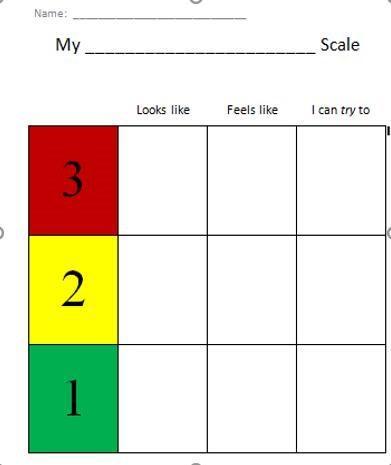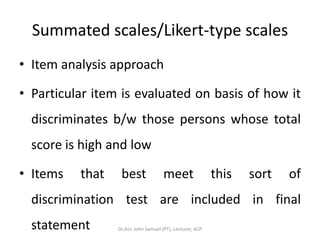44 response scales how many points and what labels
Survey Rating Scales to Guide Survey Respondents Effectively Five point scales are most popular followed by seven point scales. These scale ranges tend to work best. Beyond a 7 point scale participants have trouble responding the same way if they repeated the survey, so we recommend staying away from anything above 7 points. Here is an example of a 5 point Likert Rating Scale: Strongly disagree Disagee Rating Scale: Definition, Survey Question Types and ... Rating Scale Definition. Rating scale is defined as a closed-ended survey question used to represent respondent feedback in a comparative form for specific particular features/products/services. It is one of the most established question types for online and offline surveys where survey respondents are expected to rate an attribute or feature.
What Is the Best Response Scale for Survey and ... points use for their survey and questionnaire. Taken as a whole this study suggests using of seven-point rating scale and if there is a need to have respondent to be directed on one side, then six-point scale might be the most suitable. Key Words Response Scale, Rating Scale, Attitude Scale, Liker Scale, Scaling Method, Response Rate,

Response scales how many points and what labels
Likert Scale Response Anchors - Sawtooth Software Below are some popular Likert-type scales that you can use in your Sawtooth Software CiW (general interviewing) questionnaires. Level of Acceptability Totally unacceptable Unacceptable Slightly unacceptable Neutral Slightly acceptable Acceptable Perfectly Acceptable Level of Appropriateness Absolutely inappropriate Inappropriate User Experience Rating Scales with 7, 11, or 101 Points ... To ease comparison, all 7- and 11-point data were converted to a 0-100 (101-point) scale. For 11-point items, the conversion was to simply multiply scores by 10. For 7-point items, the conversion was to subtract 1 from the score, then multiply by 100/6 (which, for example, converts a 1 to 0 and a 7 to 100). Yes, there is a right and wrong way to number rating scales Bipolar scales require seven scale points, three around each side of the midpoint-again a midpoint that truly means neutral, neither, or both. If we go back to our school principal example, she would ask if the school day was: Much too long, Somewhat too long, A little too long, About right, A little too short, Somewhat too short, Much too short.
Response scales how many points and what labels. A classification of response scale characteristics that ... In total, they considered more than 280 possible choices, among which 40 choices are related to the design of the scale and belong to 17 characteristics. Table 2 in Appendix provides the list of response scales' characteristics and the choices considered by these authors. How to Label Response Scale Points in Your Survey | Qualtrics Here's an example of a seven-point bipolar scale where, through the use of appropriate modifiers, all responses are mutually exclusive of one another. Finally, to ensure that you get the highest-quality data possible, keep these four guidelines in mind as you practice labeling response scales: Survey Response Scales - Answer Format and Types of Questions Three-point, five-point, and seven-point scales are all included in the umbrella term "rating scale". A rating scale provides more than two options, in which the respondent can answer in neutrality over a question being asked. Examples: 1. Three-point Scales Good - Fair - Poor Agree - Undecided - Disagree Extremely- Moderately - Not at all 5 Point Likert Scale Analysis, Interpretation and Examples The 5-point Likert scale contains 5 response options that will consist of two extreme sides and a neutral option linked to the middle answer options. Examples of a 5-point rating scale for measuring satisfaction are: Very Satisfied, Satisfied, Neutral, Dissatisfied, and Very Dissatisfied.
PDF Typical Survey Response Scales - STLHE Typical Survey Response Scales ... have a maximum reliability and validity at 7 points whereas unipolar scales (e.g., Not True at all to Completely True) have a maximum reliability and validity at 5 points (Krosnick & Fabrigar, 2003) n Numeric labels seem to increase confusion rather than verbal labels (Krosnick & Fabrigar, 2003) ... 4 Measurement Scales Every Researcher Should Remember ... A Likert scaletypically contains an odd number of options, usually 5 to 7. One end is labeled as the most positive end while the other one is labeled as the most positive one with the label of 'neutral' in the middle of the scale. The phrases 'purely negative' and 'mostly negative' could also have been 'extremely disagree' and 'slightly disagree'. A Search for the optimum feedback scale Thus when defining an optimum response scale it is important to consider scales which are frequently used. The Mayflower organisation 2, which regularly implements surveys, has recommended four five-point scales found to be especially effective: 1) Far too much, too much, about right, too little, far too little. Survey rating scales 1-5: Understand your audience better ... Rating scales are common in our day-to-day lives, such as the various apps for monitoring depression, anxiety, stress, and overall well-being. They all use rating scales so you can track your responses over time. Many organizations use rating scale surveys to learn how to provide better value to clients and customers.
Your Guide to Rating Scale Questions in 2022 - Qualtrics In practice, this means the response options for a satisfaction question your Likert scale labels should look like this: If you're dealing with an idea or construct that ranges from zero to positive - think effectiveness - (these are known as unipolar constructs) then you'll go with a 1-5 point scale. Survey Response Scales: How to Choose the Right One | CXL Survey response scales can be embedded in the survey (e.g., 1-5, 1-10, etc.), chosen via a drop-down menu, or included as part of the survey language. No matter how you choose to display the scale, the default ranges affect the precision of your data. For example, if a survey asks your age, a default range of 20-25 instead of 20-30 has ... 20 Free Ready-Made Survey Rating Scale Examples | On a ... Four or six-point scales make your respondent choose between "for" and "against." You would love to have objective data, after all. How strongly do you agree or disagree with the statements? Strongly Disagree Disagree Neither Agree nor Disagree Agree Strongly Agree Person A is a highly-qualified specialist Person A is an efficient project manager 5 Color, Labels, and Interpretive Heuristics for Response Scales These items asked respondents to rate how successful, happy, overweight, nervous, fit, and moody they were on seven-point scales, with the endpoints labeled "Not at all _______" and "Very ________" (for example, "Not at all successful" and "Very successful"). The first item had been used by Schwarz and his colleagues (Schwarz et al., 1991 ).
Performance Rating Scale - How to build a fail proof ... The 5 point rating scale. The 5 point rating scales are one of the most widely used performance rating scales in the world. The method to rate an employee is fairly simple. The reviewer has to rate each employee out of 5 with 3 being the midpoint. Anything beyond 3 is considered that the employee is exceeding expectations.
Sample Likert Scales // Division of Student Affairs ... Likert-Type Scale Response Anchors. Citation: Vagias, Wade M. (2006). Likert-type scale response anchors. Clemson International Institute for Tourism & Research Development, Department of Parks, Recreation and Tourism Management. Clemson University.
A classification of response scale characteristics that ... In total, they considered more than 280 possible choices, among which 40 choices are related to the design of the scale and belong to 17 characteristics. Table 2 in Appendix provides the list of response scales' characteristics and the choices considered by these authors.
Should All Scale Points Be Labeled? - MeasuringU For example, coming up with labels for each of the points on the eleven-point Likelihood to Recommend item would likely be impractical; endpoints and a neutral label may be all that can be done. But labeling each response option for five- and seven-point scales is practical and a fairly common practice.
The 4,5, and 7 Point Likert Scale + [Questionnaire Examples] 3 Point Likert scale is a scale that offers agree and disagree as to the polar points along with a neutral option. Like the 2-point scale, the 3 point scale is also used to measure Agreement. Options will include: Agree, Disagree, and Neutral. 6 Points Likert Scale A 6 point Likert scale forces choice and gives better data.
How to Label Your 10-Point Scale - Versta Research Common response scales used in a wide variety of surveys are significantly related to the amount of item non-response. Specifically, we found that 1-10 response scales produced much higher levels of missing data than 0-10 scales and that 0-10 scales with 5 anchored as a midpoint consistently had the smallest amount of data missing.
15 Common Rating Scales Explained - MeasuringU The classic Likert item uses a 5-point response scale, but you can use 7, 9, or other points, too. (Although someone will have a strong opinion about the "right" number of steps.) Because the response scale is about agreement, be sure items are phrases participants can agree or disagree to.
Survey Scale: Definitions, Types + [Question Examples] In a graphic rating scale, the answer options provided are placed on a scale of 1-3, 1-5, and so on. Respondents can choose an option on the scale that reflects their rating for a specific assertion in the data collection context. A good example of this type of rating scale is the Likert scale . Graphic Rating Scale Question Sample

17 Best images about 5 point scales and regulation scales on Pinterest | Charts, Classroom and ...
PDF Response scales - UIC half of respondents were randomly assigned to rate from 0 to 10 with endpoints labeled "not at all successful" and "extremely successful" half of respondents were randomly assigned to rate from -5 to +5 with endpoints labeled "not at all successful" and "extremely successful" only 9% of respondents rated their success either a "9" or a "10" on …
Yes, there is a right and wrong way to number rating scales Bipolar scales require seven scale points, three around each side of the midpoint-again a midpoint that truly means neutral, neither, or both. If we go back to our school principal example, she would ask if the school day was: Much too long, Somewhat too long, A little too long, About right, A little too short, Somewhat too short, Much too short.
User Experience Rating Scales with 7, 11, or 101 Points ... To ease comparison, all 7- and 11-point data were converted to a 0-100 (101-point) scale. For 11-point items, the conversion was to simply multiply scores by 10. For 7-point items, the conversion was to subtract 1 from the score, then multiply by 100/6 (which, for example, converts a 1 to 0 and a 7 to 100).
Likert Scale Response Anchors - Sawtooth Software Below are some popular Likert-type scales that you can use in your Sawtooth Software CiW (general interviewing) questionnaires. Level of Acceptability Totally unacceptable Unacceptable Slightly unacceptable Neutral Slightly acceptable Acceptable Perfectly Acceptable Level of Appropriateness Absolutely inappropriate Inappropriate














Post a Comment for "44 response scales how many points and what labels"